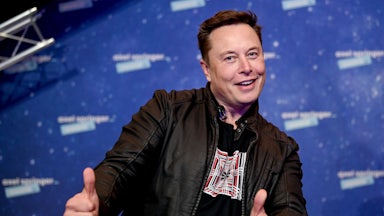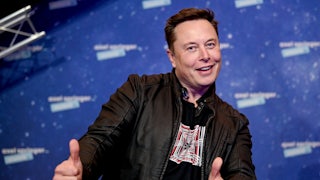Donald Trump, the twice-impeached former president, is permanently banned from Twitter. If you didn’t see this coming—if you expected Trump to return to shit-posting after being sent to the corner for a time-out of indefinite duration—that’s understandable. There’s been little clarity about just what Twitter intends to do with Trump, or any similarly toxic users, in the long term. The news about his lifelong ban wasn’t shared in Tuesday’s Twitter earnings call. Instead, it was announced Wednesday by Ned D. Segal, the company’s CFO, in an interview on CNBC.
As for the earnings call, it offered a grim look at a long-struggling, highly valued public company whose executive leadership seems to have no sense of what its users want. Referring vaguely to a multiyear product roadmap, and hinting at success on tackling the ubiquitous problem of harassment, CEO Jack Dorsey and Segal pronounced Twitter in excellent health. Revenues—85 percent of which come from advertising—are up, along with the service’s user base: The company reports 192 million “average monetizable [daily active users],” 80 percent of whom are in the United States.
Whether Twitter knows what to do with these tens of millions of users is another question entirely, one that went unasked by analysts on the call. Recent reporting about Twitter shows a company in perpetual disarray, promising a soon-to-be “decentralized” service that empowers users while paradoxically assuring investors that it’s taking more control over its platform. Meanwhile, instead of procuring more staff to address issues of harassment and content moderation, Twitter has introduced a test product that asks users themselves to act as moderators, flagging inappropriate content and adding context to avoid the spread of fake news. But this seems like yet another tactic to avoid responsibility for the content on its site. Anyone who has spent more than a few hours on Twitter knows that its user base is supremely incapable of policing itself.
If Twitter has any sense of its future, it seems to lie in doubling down on targeted advertising and copying features from competitors. As Segal said during the earnings call, the company has been working on a product called “Twitter Click ID, which will help you attribute a click from Twitter to an advertiser’s website without a cookie as the world moves away from cookies over time.” The company is also trying to appeal to small-business advertisers and to create more opportunities to buy products via tweets. And it’s looking at ways to diversify its business model, with a subscription-based, ad-free Twitter floated as one possibility. But in terms of products and features, everything new and novel with Twitter can be sourced to a competitor: Twitter now offers Fleets (ephemeral posts, a feature that many companies have copied from Snapchat), Spaces (an audio hangout feature copied from buzzy startup Clubhouse), and Revue, a newsletter company it recently purchased.
But these are mere baubles in the grander scheme. Nothing seems more important to Dorsey than the vague prospect of “decentralization,” which he thinks will address anything from content moderation issues to Section 230 liability to algorithmic curation. It could also make for a much bigger Twitter. “The most important thing to focus on, in terms of decentralizing social media, is that it creates a much larger corpus of conversation,” said Dorsey. “It gives many more inputs to public conversation.” To handle this enormous corpus of decentralized information, Jack proposed a marketplace of algorithms, where users could choose the sorting mechanisms and content filters that would most resonate with their needs. “The thing that gets me really excited about all of this is, we will have access to a much larger conversation,” said Dorsey, “and we’ll be able to put many more ranking algorithms that suit different people’s needs on top of it.”
What about harassment, toxic users, fake news, foreign governments censoring civil rights groups, and other viral terrors? Where are the armies of moderators, the appeal mechanisms for dealing with harassment or bans, the devotion to protecting speech against tinpot dictators? In the earnings call, Dorsey said little on these subjects, except that “our focus on promoting more healthy conversation is a growth vector.” He may not be wrong—Twitter said it added users after Trump’s ban at an increased rate—but it’s a dispiriting way to talk about what passes for the digital public sphere. While Dorsey can occasionally be thoughtful, eschewing the bombast of other tech CEOs, he makes up for it with a lack of vision and a diffidence that raises questions about whether he knows what he’s talking about.
That matters especially for Twitter’s dimly described plans to become a more decentralized service. The idea seems inspired as much by Dorsey’s much-expressed love for Bitcoin, and the distributed database technology underlying it, as by any real desire to restructure power relations between Twitter users and the company. Tech leaders often confuse “decentralization” with “democratization,” believing that they are empowering users when they’re doing anything but. For instance, Dorsey recently said he sees decentralization as an improvement to the perpetually unsolved problem of content moderation, making each user a moderator of their customized Twitter service. But that would only increase the workload for users, making them do more labor to maintain a peaceful timeline.
It’s unclear if Twitter’s decentralization project will actually yield anything. Twitter announced the plan, dubbed “bluesky,” in December 2019, but a recent TechCrunch investigation showed the project had barely gotten off the ground, with key staff yet to be hired. Others wonder why Twitter doesn’t team up with some of the more established decentralized social media projects, like Mastodon. As The Verge noted after the initial announcement in 2019, “Bluesky’s mission slotted right into a Silicon Valley cliche: a tech company ‘discovering’ some long-standing problem and swooping in with a naive solution.”
Naïve solutions, hurled at the whiteboard with abandon, seem to define Twitter’s approach to problem-solving. It doesn’t matter whether it’s dealing with content moderation, the under-addressed problem of harassment, or a president inciting violence. A haphazard feeling endures, a sense that the company is figuring all this out along with us. This is how Twitter can promise hundreds of millions of people a decentralized, ad-free future along with more surveillance-based ad products for its real customers: corporations and ad agencies. Unlike Facebook and Google, which went all-in on scale and data collection, Twitter still hasn’t sorted through its inherent contradictions. But when it does, maybe Jack will let us know on CNBC.




